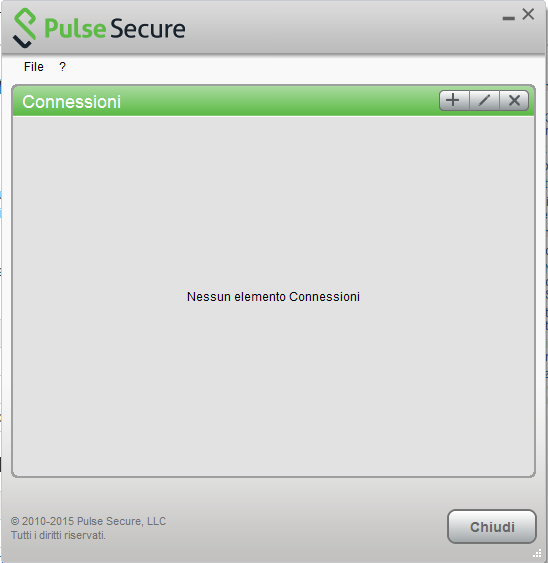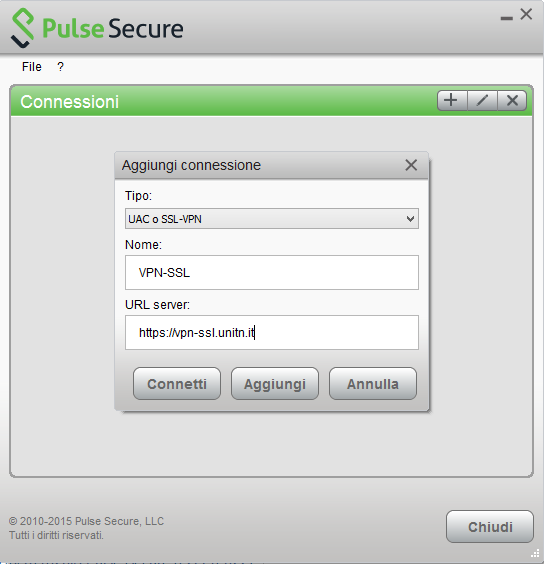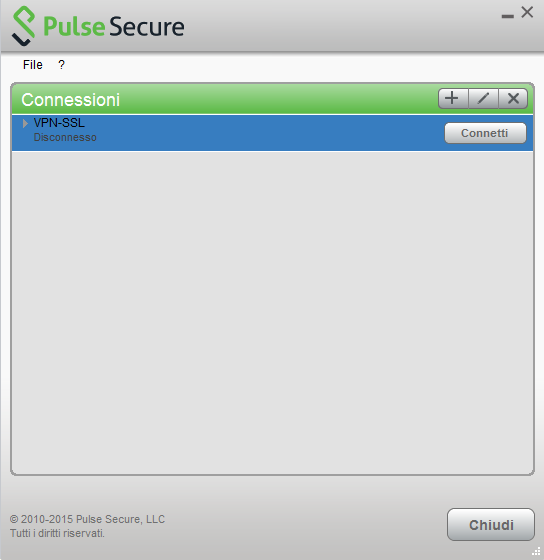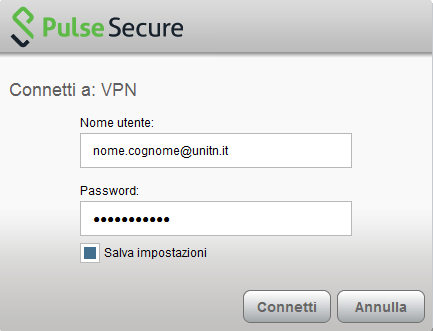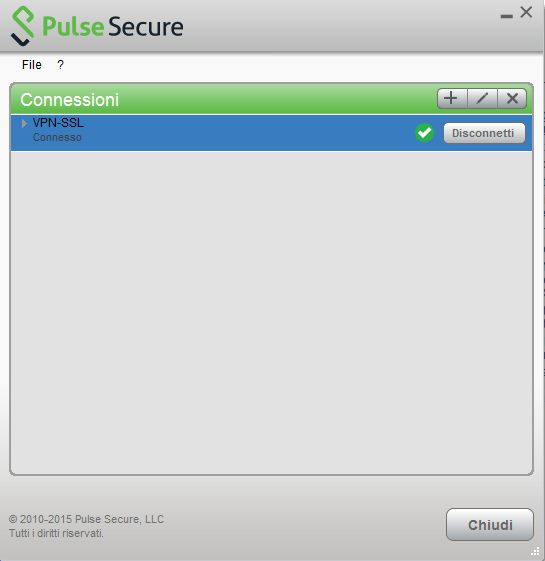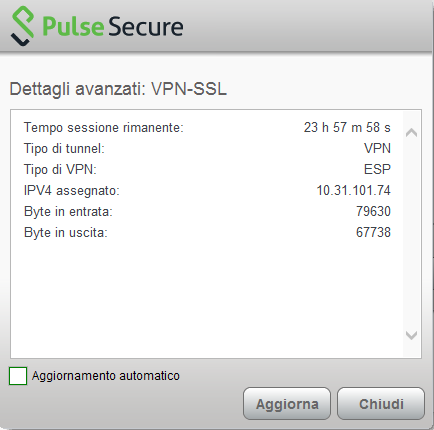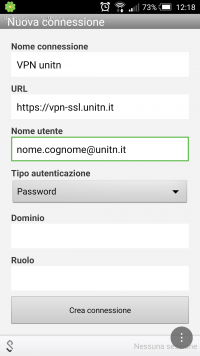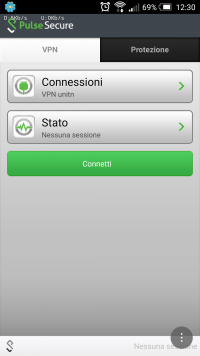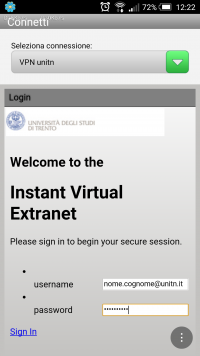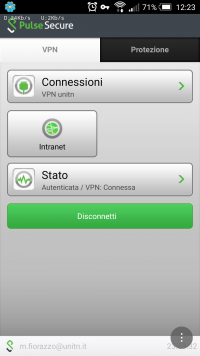Questa è una vecchia versione del documento!
Indice
Instructions for the new VPN UNITN service
WARNING: We are experiencing connection problems with the new Pulse Secure client for Linux, we are waiting for the support to resolve the issues, in the meanwhile we suggest you to use the Network Connect
Network Connect for Linux
REFERENCES: https://kb.pulsesecure.net/articles/Pulse_Secure_Article/KB40157/?q=KB40157
The VPN service allows access to internal resources of the UniTN network from external locations. It is based on SSL encryption.
For the usage and configuration of the VPN you have to install Pulse Secure, visit the right section:
| Operating System | Supported Client | Instructions |
|---|---|---|
| Windows, Macosx | Pulse Secure | Pulse Secure Desktop |
| Linux | Pulse Secure | Pulse Secure Linux |
| Mobile devices (Smartphone & Tablet) | Pulse Secure | Pulse Secure Mobile |
MACOSX, Windows (Pulse Secure)
For Mac and Safari: Warning !!! Be sure that your browser is saving the file with .dmg extension (and not .exe) as “pulse.dmg”.
After the installation, launch the Pulse Secure Application, the main screen appears:
Create a new connection by clicking the '+' sign and entering the following parameters:
To start the connection, click on <Connect>
Fill the form with the username (@unitn.it) and password:
The connection is established, you can stop the vpn clicking on <Disconnect>
You can see the Pulse Secure notification icon in the lower right area:
You can show a status window from File→Connections→Advanced Connection Details…
Linux Pulse Secure Client
WARNING: We are experiencing connection problems with the new Pulse Secure client for Linux, we are waiting for the support to resolve the issues, in the meanwhile we suggest you to use the Network Connect
Network Connect for Linux
| Pulse Secure for Linux Download |
|---|
| Linux CentOS Pulse Secure 8.1r7.0-b41041 |
| Linux Ubuntu (> 14.04) Pulse Secure 8.1r7.0-b41041 |
Download the package installer to the Linux client then run the installer using the following command:
Debian-based Linux (Ubuntu):
dpkg -i <package name>
RPM-based Linux (CentOS):
rpm -ivh <package name>
For example, if the Pulse Linux client is saved in /$HOME/Downloads on Ubuntu, then the command would be:
sudo dpkg -i /$HOME/Downloads/ps-pulse-linux-8.1r7.0-b41041-ubuntu-debian-installer.deb
The script will prompt the user to install any missing dependent packages if they are not already installed (in this case libc6-i386 and lib32z1):
user@host:~$ sudo dpkg -i /$HOME/Downloads/ps-pulse-linux-8.1r7.0-b41041-ubuntu-debian-installer.deb (Reading database ... 154703 files and directories currently installed.) Preparing to replace pulse 8.1 (using .../ps-pulse-linux-8.1r7.0-b41041-ubuntu-debian-installer.deb) ... Unpacking replacement pulse ... Setting up pulse (8.1) ... Please execute below commands to install missing dependent packages apt-get install libc6-i386 apt-get install lib32z1 Please refer /usr/local/pulse/README for instructions to launch the Pulse Client
You have to download the device certificate from the Secure Access server in DER format:
NB: this is has to be done only one time
user@host:~$ openssl s_client -connect vpn-ssl.unitn.it:443 -showcerts < /dev/null 2> /dev/null | openssl x509 -outform der > /$HOME/Downloads/vpn-ssl.crt
You can also download the certificate from here vpn-ssl.zip and unzip it with:
user@host:~$ unzip /%HOME/Downloads/vpn-ssl.zip
Use the following command to launch the VPN client (you will be asked for the UniTN password):
/usr/local/pulse/PulseClient.sh -h vpn-ssl.unitn.it -u nome.cognome@unitn.it -f /$HOME/Downloads/vpn-ssl.crt -U https://vpn-ssl.unitn.it -r AR-unitn-ldap-ad
Foe example::
user@host:~$ /usr/local/pulse/PulseClient.sh -h vpn-ssl.unitn.it -u username@unitn.it -f /$HOME/Downloads/vpn-ssl.crt -U https://vpn-ssl.unitn.it -r AR-unitn-ldap-ad Reading package lists... Done Building dependency tree Reading state information... Done lib32z1 is already the newest version. libc6-i386 is already the newest version. 0 upgraded, 0 newly installed, 0 to remove and 557 not upgraded. executing command : /usr/local/pulse/pulsesvc -h vpn-ssl.unitn.it -u username@unitn.it -f /$HOME/Downloads/vpn-ssl.crt -U https://vpn-ssl.unitn.it -r AR-unitn-ldap-ad VPN Password:
After few seconds the vpn connection is established, you have to leave this terminal window open and you can monitor the connection from another terminal window with the command:
user@host:~$ /usr/local/pulse/PulseClient.sh -S
Connection Status :
connection status : Connected
bytes sent : 1722
bytes received : 2586
Connection Mode : ESP
Encryption Type : AES128/SHA1
Comp Type : None
Assigned IP : 10.31.0.80
To kill the connection:
user@host:~$ /usr/local/pulse/PulseClient.sh -K
References - official documentation:
https://kb.pulsesecure.net/articles/Pulse_Secure_Article/KB40126/?q=linux&l=en_US&fs=Search&pn=1&atype=
Mobile Devices
REQUISITI
- iPhone, iPod Touch, iPad
- Android devices 4.0 or higher
- Windows Mobile 6.5
INSTRUCTIONS: (screenshots related to Android version 5)
- Install the app “Pulse Secure” from ther App Store or Google Play
- Start the application “Pulse Secure”
- Create a new connection by entering:
- “Connection Name” (your choice)
- “URL”: https://vpn-ssl.unitn.it/
- “User Name” (in the form username@unitn.it)
- Touch on “Create Connection”
- Tap on “Connect”, enter your password and select “Sign In” (possibly accept the warning about security and trusted application)
- after a while, the connection is established, verify it by tapping on “Status”
- to terminate the session, tap on “Disconnect”
Features of vpn-ssl service
IP addresses assigned to the clients
To connected vpn clients is assigned an ip in the range from 10.31.0.10 to 10.31.0.254
"split-tunnel" mode
The VPN connection provides traffic directed to intranet IP using the VPN tunnel while traffic to other networks (eg Internet) is provided by standard client connection (eg ADSL at home).
NB: the routing change doesn't affect the already “established” connections at the moment of the connection
User-side Firewall rules
VPN traffic is encrypted in SSL and uses TCP destination port 443. For the ESP mode (which increases performance) you must open the UDP destination port 4500 too.

